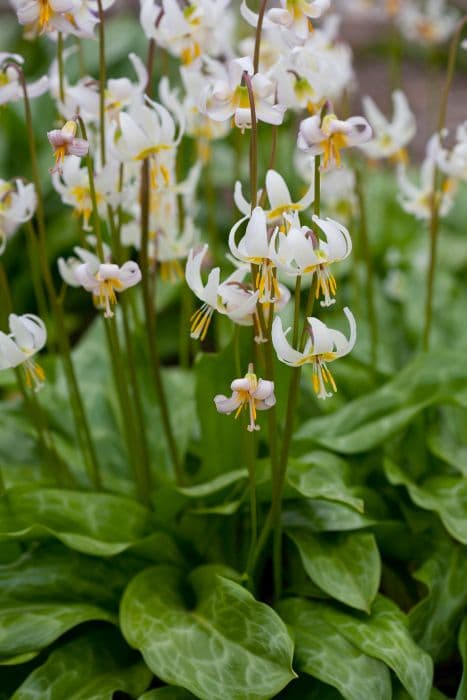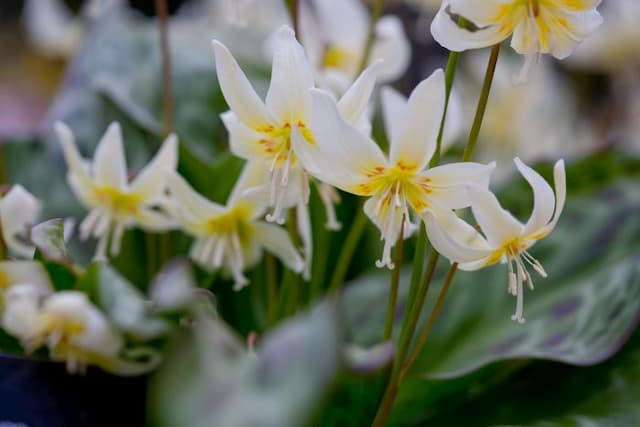Parrot Tulip Tulipa 'Zampa Parrot' (10)

ABOUT
The Tulipa 'Zampa Parrot', commonly referred to as the parrot tulip, is renowned for its flamboyant and extravagant blooms. These flowers exhibit intricate petals that are deeply fringed, feathered, and twisted, creating an almost ruffled texture that is visually striking and gives the appearance of a parrot's plumage, hence the name. The petals have a combination of bold and vibrant colors which often include streaks, flares, and varying gradients of hues that blend together beautifully. This kaleidoscope of color can range from bright reds to deep purples, often accentuated with contrasting shades like greens and yellows that add depth and complexity to the blossom. The leaves of this tulip are typically a grayish-green color, broad and lance-shaped, providing a strong backdrop that makes the vivid flowers stand out in any setting. The plant's overall impression is one of opulence and drama, making it a popular choice for gardens and floral displays that seek to make a bold statement.
About this plant
 Names
NamesFamily
Liliaceae
Synonyms
Zampa Parrot Tulip
Common names
Tulipa 'Zampa Parrot'.
 Toxicity
ToxicityTo humans
The plant commonly known as Parrot Tulip can be toxic if ingested. The entire plant, especially the bulb, contains substances that can cause nausea, vomiting, and diarrhea if eaten in large quantities. In addition to gastrointestinal irritation, dizziness, and even cardiac problems may occur in severe cases. Contact with the sap may also cause minor skin irritation. It is important to handle Parrot Tulips with care and avoid ingesting any part of the plant to prevent these symptoms.
To pets
Parrot Tulip toxicity is also a concern for pets, such as cats and dogs. The plant contains compounds that can cause vomiting, depression, diarrhea, and hypersalivation if ingested. The most toxic part is the bulb, but all parts of the Parrot Tulip can be harmful to pets. Ingesting Parrot Tulips may lead to gastrointestinal upset and, in severe cases, could potentially lead to more serious symptoms like changes in heart rate and respiration. Pet owners should ensure that their animals do not consume any part of this plant.
 Characteristics
CharacteristicsLife cycle
Perennials
Foliage type
Deciduous
Color of leaves
Green
Flower color
Varies
Height
1-2 feet (30-60 cm)
Spread
6 inches (15 cm)
Plant type
Bulb
Hardiness zones
3-8
Native area
Central Asia
Benefits
 General Benefits
General Benefits- Decorative Appeal: Tulipa 'Zampa Parrot', commonly known as the Parrot Tulip, features unique and vibrant petals that add aesthetic value to any garden or floral arrangement.
- Pollinator Attraction: The Parrot Tulip's bright colors and shape can help attract bees and other pollinators, supporting the local ecosystem.
- Seasonal Interest: Blooming in spring, Parrot Tulips provide a welcome burst of color after the winter months, signaling the change of seasons.
- Easy to Grow: They are relatively easy to cultivate and maintain, making them suitable for both novice and experienced gardeners.
- Variety of Colors: The Parrot Tulip comes in a wide range of colors, allowing for versatility in garden design and color theming.
- Cut Flower Usage: With their striking appearance, Parrot Tulips are popular as cut flowers and can bring the beauty of the garden indoors.
- Garden Diversity: Adding Parrot Tulips to a garden can increase its floral diversity and create more complex and interesting landscapes.
- Potential for Naturalizing: These tulips, if conditions are right, can naturalize and return year after year to enliven a garden space.
- Cultural Significance: Tulips, including the Parrot variety, have been celebrated in art and culture, offering historical and cultural interest to enthusiasts.
- Seasonal Celebrations: The spring bloom time of Parrot Tulips coincides with various spring holidays and festivals, making them a timely addition to celebrations.
 Medical Properties
Medical PropertiesThis plant is not used for medical purposes.
 Air-purifying Qualities
Air-purifying QualitiesThis plant is not specifically known for air purifying qualities.
 Other Uses
Other Uses- Photography Subject: The unusual and vivid shapes of the Parrot tulip's petals make them an excellent subject for both professional and amateur photographers.
- Edible Decoration: The petals of Parrot tulips can be used as edible garnishes on salads and desserts, providing a splash of color and elegance to the presentation of dishes.
- Fashion Inspiration: The striking patterns and colors of the Parrot tulip can inspire textile designs and patterns in the fashion industry.
- Color Therapy: The vibrant colors of the Parrot tulip can be used in color therapy sessions to stimulate the senses and promote a sense of well-being.
- Art Classes: The complex petal forms of the Parrot tulip can serve as an intricate subject for art students learning to explore shapes, shadows, and textures in their work.
- Craft Projects: Dried Parrot tulip petals can be used in crafting activities, such as making bookmarks, greeting cards, or decoupage projects.
- Event Theme Inspiration: The unique look of Parrot tulips can serve as a theme for events or parties, providing a distinctive and memorable decorative motif.
- Learning Tool: The diverse colors and forms of Parrot tulips can be used as educational tools for teaching children about plant biology and horticulture.
- Floral Perfumery: Parrot tulip petals can be used in the natural perfumery industry to create floral waters or to add subtle scents to potpourri blends.
- Jewelry Making: The petals of the Parrot tulip can be preserved in resin to make unique and attractive pieces of floral jewelry such as necklaces, earrings, or bracelets.
Interesting Facts
 Feng Shui
Feng ShuiThe Parrot Tulip is not used in Feng Shui practice.
 Zodiac Sign Compitability
Zodiac Sign CompitabilityThe Parrot Tulip is not used in astrology practice.
 Plant Symbolism
Plant Symbolism- Love: The Tulip is often associated with deep love and affection. The 'Zampa Parrot' variety, with its vivid and elaborate petals, symbolizes a declaration of love that is both passionate and dramatic.
- Passion: The intense and striking appearance of 'Zampa Parrot' Tulips signifies strong emotions and fervent passion.
- Perfect Lover: Tulips, in general, are believed to represent the concept of a perfect lover. The unique pattern of 'Zampa Parrot' evokes the idea of an extraordinary and captivating companion.
- Royalty: The luxurious look of the 'Zampa Parrot' Tulip, with its curly petals, may denote royalty and a regal bearing, suggesting an air of elegance and nobility.
- Prosperity: In some cultures, the Tulip is a symbol of abundance and prosperity. The exotic 'Zampa Parrot' may represent a wish for wealth and success.
- Spring: As a spring-blooming flower, Tulips in general, including 'Zampa Parrot', herald the arrival of spring and symbolize rebirth and new beginnings.
- Charity: Given their generous blooms, Tulips can be associated with the idea of charity and giving. 'Zampa Parrot', with its exuberant shape, may amplify this sentiment.
- Forgiveness: The Tulip is sometimes seen as a flower of forgiveness, and the 'Zampa Parrot' Tulip, with its striking colors, might represent a bold and heartfelt apology.
- Perfect and Deep Love: Tulips are further linked to perfect and everlasting love, and the 'Zampa Parrot' variety, in particular, represents a love that is not only ideal but also profound and enduring.
- Transformation: The intricate form of 'Zampa Parrot' can symbolize transformation, reflecting the flower's potential to evoke personal change and growth.
 Water
WaterParrot tulips, including 'Zampa Parrot', typically require thorough watering when their soil begins to dry out. It's essential to avoid overwatering, which can lead to bulb rot. During the growing season, it's advisable to water them once a week with about half a gallon per square yard, depending on the weather conditions. Ensure that the water penetrates deeply into the soil to encourage deep root growth. When the plants are dormant, right after their leaves have died back, cease watering to allow the bulbs to rest.
 Light
LightParrot tulips, like 'Zampa Parrot', thrive in full sunlight to partial shade. They perform best when they receive at least six hours of direct sunlight each day, so planting them in a spot that gets morning light with some afternoon shade is ideal. Avoid deeply shaded areas as insufficient light can lead to weak stems and reduced flowering.
 Temperature
TemperatureThe Zampa Parrot tulip prefers cooler temperatures and is generally hardy in USDA zones 3 through 8. They can withstand minimum temperatures of around -40 degrees Fahrenheit when dormant, but during their growing season, a range between 60-70 degrees Fahrenheit is ideal. Parrot tulips bloom in early to mid-spring, so they are typically not exposed to extreme heat.
 Pruning
PruningPruning 'Zampa Parrot' tulips involves deadheading spent flowers to conserve the plant's energy for next season's bloom. Remove only the bloom and stem, leaving the foliage intact, as the leaves will continue to photosynthesize and replenish the bulb. Prune after the flowers fade in late spring, but before the foliage has died back completely, usually around early summer.
 Cleaning
CleaningNot needed
 Soil
SoilParrot Tulips, like 'Zampa Parrot', thrive in well-draining, fertile soil with a pH of 6.0 to 7.0. The ideal soil mix for this tulip would be a combination of loam, sand, and compost to ensure proper drainage and fertility. To further optimize the conditions, adding bone meal or bulb fertilizer at planting time can promote healthy growth.
 Repotting
RepottingParrot Tulips don't typically grow well when repotted, as they perform best when planted directly into the ground or in outdoor containers. Consequently, repotting should be done every 3 to 5 years, if necessary, to rejuvenate the soil and divide overcrowded bulbs.
 Humidity & Misting
Humidity & MistingParrot Tulips, such as the 'Zampa Parrot', prefer average outside humidity levels. They do not require high humidity environments and can withstand the wide range of humidity typically found in outdoor gardens.
 Suitable locations
Suitable locationsIndoor
Place Parrot Tulip in bright, indirect light and cool temps.
Outdoor
Plant Parrot Tulip bulbs in autumn, full sun.
Hardiness zone
3-8 USDA
 Life cycle
Life cycleThe life of a Parrot Tulip ('Zampa Parrot') begins with a dormant bulb planted in the fall before the first frost. In early to mid-spring, the bulb breaks dormancy and a shoot emerges from the soil, developing into a stem with leaves and a distinctive flower bud marked by fringed, curled, and brightly colored petals. After flowering, which generally lasts for a few weeks, the bloom wilts and dies, signaling the plant's shift to energy storage for the next season. The leaves will photosynthesize and send energy back to the bulb as they turn yellow and wither away by early summer. The bulb then goes into a period of dormancy during the hot summer months. In the next growth cycle, the bulb divides, creating small offshoot bulbs called bulbils that can be separated and planted to produce new plants.
 Propogation
PropogationPropogation time
Spring
The most popular method for propagating Tulip 'Zampa Parrot' is by separating and planting the bulb offsets that form naturally around the parent bulb. Typically, this is done in the fall, just before the onset of cold weather when the bulbs are dormant. Gardeners should carefully dig up the clumps of bulbs and gently separate the offsets from the main bulb. Smaller bulblets can be replanted immediately at a depth of about 6 to 8 inches (approximately 15 to 20 centimeters) and spaced about 4 to 6 inches (approximately 10 to 15 centimeters) apart to allow for adequate growing room. They will typically bloom after a year or two when they have matured. This simple division method is effective in creating a greater number of plants while maintaining the unique qualities of the 'Zampa Parrot' tulip.








